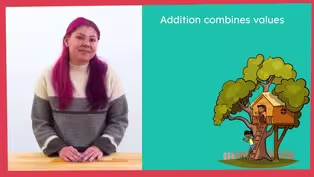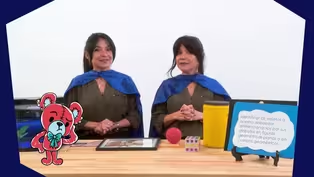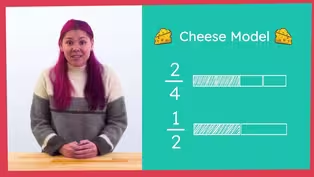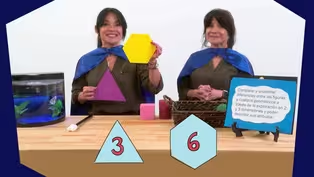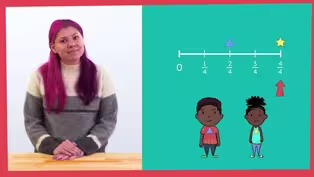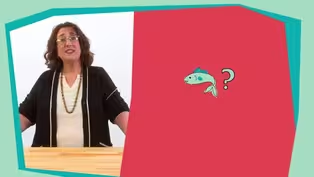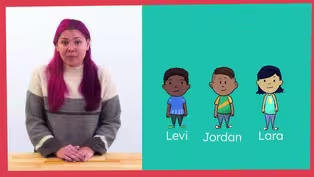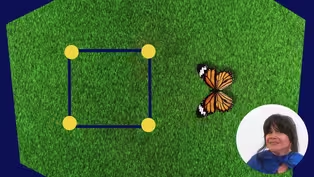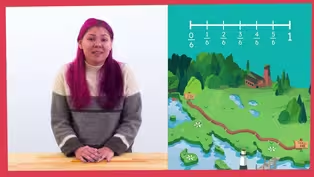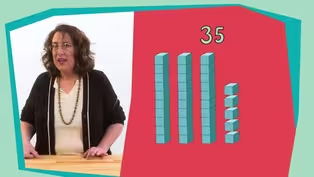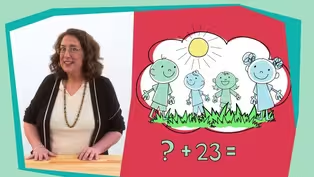
Episode 26 | Math Lessons
4/12/2021 | 28m 46sVideo has Closed Captions
Math lessons for early learners, led by NC teachers.
The first lesson (aimed at 3rd graders) helps students explore the relationship between addition and subtraction. The second lesson (aimed at PreK-K learners) helps early learners understand the number of objects is the same whether scattered in a line or in a 5 frame. Classroom Connection is your At-Home Learning companion where children love to learn. All lessons are led by NC educators.
Problems playing video? | Closed Captioning Feedback
Problems playing video? | Closed Captioning Feedback
At-Home Learning Presents: Classroom Connection is a local public television program presented by PBS NC

Episode 26 | Math Lessons
4/12/2021 | 28m 46sVideo has Closed Captions
The first lesson (aimed at 3rd graders) helps students explore the relationship between addition and subtraction. The second lesson (aimed at PreK-K learners) helps early learners understand the number of objects is the same whether scattered in a line or in a 5 frame. Classroom Connection is your At-Home Learning companion where children love to learn. All lessons are led by NC educators.
Problems playing video? | Closed Captioning Feedback
How to Watch At-Home Learning Presents: Classroom Connection
At-Home Learning Presents: Classroom Connection is available to stream on pbs.org and the free PBS App, available on iPhone, Apple TV, Android TV, Android smartphones, Amazon Fire TV, Amazon Fire Tablet, Roku, Samsung Smart TV, and Vizio.
Providing Support for PBS.org
Learn Moreabout PBS online sponsorshipMore from This Collection
Math lessons for early learners, led by NC teachers.
Video has Closed Captions
Math lessons for early learners, led by NC teachers. (28m 46s)
Video has Closed Captions
Math lessons for early learners, led by NC teachers. (28m 46s)
Video has Closed Captions
Math lessons for early learners, led by NC teachers. (28m 46s)
Video has Closed Captions
Math lessons for early learners, led by NC teachers. (28m 46s)
Video has Closed Captions
Math lessons for early learners, led by NC teachers. (28m 46s)
Video has Closed Captions
Math lessons for early learners, led by NC teachers. (28m 46s)
Video has Closed Captions
Math lessons for early learners, led by NC teachers. (28m 46s)
Video has Closed Captions
Math lessons for early learners, led by NC teachers. (28m 46s)
Video has Closed Captions
Math lessons for early learners, led by NC teachers. (28m 45s)
Video has Closed Captions
Math lessons for early learners, led by NC teachers. (28m 46s)
Video has Closed Captions
Math lessons for early learners, led by NC teachers. (28m 45s)
Video has Closed Captions
Math lessons for early learners, led by NC teachers. (28m 46s)
Providing Support for PBS.org
Learn Moreabout PBS online sponsorship[cheerful upbeat music] ♪ - [rapping] ♪ Hey, my name is Mr. R and I came to say ♪ ♪ I love Classroom Connection in a major way.
♪ What's up my super learners?
And welcome to another day to do some super learning.
How's everybody doing?
Let's see them thumbs up.
There it is.
I like to see that, now what's the best thing you can do while inside?
learn something cool with that super learning mind.
Yo, check this out.
[transitional music] - Hello.
Third grade friends, Diane here.
I'm so happy to see you today.
We're going to be talking about strategies for addition and subtraction.
Before we get started let's review what we know about the word strategies.
Let's use the Frayer model to help us out.
Are you ready?
Let's get started, to make our fair model.
You will need a piece of paper and a pen, a pencil, or a marker.
I'm going to get my supplies.
You go ahead and do the same.
[up beat music] Now that we have our supplies let's begin to make our Frayer model.
Let's take a piece of paper and folded in half hamburger style and then fold it in half again to make four equally sized rectangles.
Then in the corner of our paper, where all sides are folded we're going to fold down to make a small triangle, right?
When you unfold your paper, it should look like this.
Does yours look like mine?
Okay, great.
We're going to start with writing the word strategies in the center diamond because this is the word we need to understand more about then in the upper left rectangle we're going to define this term.
So let's write the word definition here.
In the upper right rectangle we're going to provide an example of a strategy.
So let's right example here.
And then in the lower left rectangle we'll provide a non-example or what strategies are not.
So write non-example here.
Finally in the lower right rectangle We'll draw a picture to help us visualize what strategies are.
So let's write the word picture here to remind us of what we're supposed to do.
Now we're going to define the word strategy together.
So let's write the definition in our upper left rectangle.
A strategy is a method that can be used to solve a math problem.
So if I want to solve a problem involving addition and subtraction, I could use the estimation, friendly numbers or other strategies to help me think through the problem.
I'm going to give you some time to write the definition in your Frayer model [upbeat music] - Right?
As we use strategies to help us think through the math in today's lesson you'll be able to add examples non-examples and draw a picture to share your growing toolbox of math strategies.
Let's place our Frayer model to the side and take a look at this email from one of my students.
I thought about you today when I heard this math problem that was posed by one of my students.
Do you want to hear it?
I could you use your help in giving her some ideas on how to solve it.
So the email she sent me says, dear Diane I have a big problem that I need your help with.
My brother Jose and I are competing to see who ends up with the high score in our favorite video game.
He has a score of 423 and I'm at 247.
How many more points do I need to tie his score?
Please help, Angela.
Well, mathematicians, do you think we can help her?
Awesome.
When I'm solving a problem?
I like to start by summarizing it so I can make sure that I understand what the problem is asking me to do.
Can you help me summarize this problem by telling me who is in the problem?
Exactly.
Angela and Jose, and what do we need to find out?
How many points Angela needs to get to Jose's score of 423.
What do we already know?
Angela has 247 points and her brother has 423.
Great.
I think I understand what this problem is asking me to do.
So now let's take a moment and think about how we could represent this problem with pictures, models, or numbers.
You may want to draw something out on your paper at home.
[upbeat music] All right.
Let's see what you got.
Those are all great ideas.
Let me see if I can share those one idea is to use a bar model.
One bar has 423 and the other has 247.
The first bar shows us Jose score of 423.
And this one shows Angela score of 247.
If I compare Angela scores to Jose's by putting Angela's bar on top we can see that there is an unknown number of points needed to reach 423.
That model really helps me better understand the problem.
Another idea that I heard you share involves a number line.
We know that Angela has 247 points.
I'll put this here and then we need to get to Jose's 423 points.
So I'll put that here for both of these representations it looks like I need to find the number of points needed to get from 247 to 423.
We'll call that the distance looking at our two models.
How could I represent this problem with an equation?
Exactly.
I could use 247 plus an unknown number equals 423.
That makes sense to me.
Before we solve let's estimate the missing add end.
So that we'll know if our solution is reasonable.
I'm going to estimate by rounding to the nearest hundred 247 is closest to 200 and 423 is closest to 400.
So that's 200 plus something equals 400.
That would be 200.
Angela would need about 200 more points to tie her brother.
Okay.
Ready to solve?
Let's start by looking at our equation again.
We'll call this an adding up strategy and I'll use the number line to show this.
I need to start at 247 and add until I get to 423 there are lots of different ways that we could do this.
But one thing that I try is to use friendly numbers or the tens and hundreds these numbers can be easily added together.
Let's see what that might look like.
Right?
So I know that if I add three to 247, I land on 250 and 250 is a friendly number, 250 plus 50 more.
We'll put me at 300 and 300 is another friendly number.
Then I can add 100 more to get to 400.
Then adding 23 will get me to 423.
How do I know how much I added altogether?
Right!
We want to look at the jumps.
So we have added all of our jumps, 3, 50, 100, and 23.
I don't have to add in any particular order so I can do it in a way that makes sense to me.
And you can do it in a way that makes sense to you.
I'm just going to add it in order.
So we have three plus 50 was 53 and then 53 plus 100 equals 153 and 153 plus 23 equals 176.
So 247 plus 176 equals, 423.
So Angela needs to get 176 points to tie with her brother Is 176 A reasonable answer?
Sure is our estimate was 200 and 176 is pretty close.
If I had gotten 76 as my answer I would know that my answer wasn't close to my estimate and that I would need to go back and check my work.
Could you solve this in a different way?
I'll give you a moment to try it on your own.
[upbeat music] Great.
What strategy did you use?
Could you tell me or show me?
Wow.
Those are all great strategies.
There are so many different ways that you can solve this problem.
Did you get 176 as your solution?
Great, finding different ways to solve a problem can help you become a more flexible thinker And it's fun.
Oh, before we go, let's finish up today.
By returning to our Frayer model earlier we gave a definition for strategies and math.
We said that a strategy is a method that can be used to solve a math problem.
In your Frayer model can you write an example of one of the strategies that we use today?
That's right, we used estimation and friendly numbers, like tens and hundreds to solve the problem.
I bet you came up with other strategies as well.
After the lesson I want to challenge you to add in more pictures and a non-example of math strategies into your Frayer model.
Thanks for helping me complete it.
See y'all.
- Wow.
What did they so far, so much Great learning going on next.
We're going to watch a video about North Carolina that I know you'll love.
- Hi, everybody.
Jonah says to me here today, we're heading in here to the North Carolina zoo to check out what the vet's doing, the vet is a crucial part of a zoo.
So let's call this a day in the life of a vet [piano music] - Hi - Hey, how are you?
- Good.
Lets just do the single injection first, and then we'll move into the other one.
I always get the question.
What's a normal day like for you?
And then I always respond, There is no normal day.
The only normal part or consistent part of my day is I started eight o'clock and we round with my staff and then it can go in a multitude of different directions.
So this morning, what we're going to be doing is we're going to be looking at a Florida box turtle, That's leaving us to go to the South Carolina aquarium.
So what we're going to be doing today is just kind of getting a, a good overview of how healthy is this animal.
So this particular turtle came up with these shell lesions.
You can see that little pit right there, and then right here as well.
Again, she does bite.
So we will have, have the train professional holder.
I don't want to send an unhealthy turtle to a counterpart at another facility.
So I don't want to send a sick animal there.
So I'm going to make sure that that turtle's healthy before we ship him out today.
So we're going to have you guys run away cause I'm going to run, cause he's going come out as soon as we take on to take the leave.
Clear - Yeah, that was a good, good setting as well.
Oftentimes we do the bigger procedures in the morning.
Yesterday morning, we went down and we did a an exam on a black bear, which required anesthesia.
The day before we had a fringe-eared Oryx that we had to get off the habitat or our largest habitat in the park is 40 acres.
These animals do not want to come inside.
So we had to go out there.
I had to dart him get him under anesthesia, get him off habitat.
And then the afternoons are smaller rechecks.
We're driving around the park.
We're doing rechecks on things that we may have seen a couple of days prior to that.
So the take home message, If you were coming to the North Carolina zoo what I would want you to take home is multiple things.
First.
I want you to look at how well we're taking care of the animals, how well the keepers are caring for the animals.
How good the welfare is here?
I mean, we are treating these animals with the utmost respect.
We are giving them the best healthcare that we can provide so that you, as a guest will be able to look at these animals as a masters because that's what they are.
They are the animals that are out there in the wild that are, some of them are going to do the sixth extinction crisis.
I mean, things are happening around the world where animals are dying off, are going extinct.
So these are the animals that are acting as ambassadors for you guys so that you can bring your kids.
We're looking for the next generation to be super excited about what it is that we do.
So they will go out and do the same thing that we're trying to do which is save these animals from extinction.
The other thing we want you to have a good time.
This is a beautiful park.
So come out and enjoy yourself.
We are trying to teach you about education around the park.
Conservation that we're doing because we've got boots on the ground.
We've got people out in the field doing hardcore conservation work, where we are saving animals.
I personally work in West Africa where we are working with the Ivorian government to protect forest elephants.
So again, you may see me around the park taking care of the animals that we have in the North Carolina zoo.
But, I'm also working overseas to make sure that you and your kids and your grandkids can we'll have forest elephants for the rest of your, for the rest of your lives.
And hopefully even further into the future - In a way, it would be a little bit wrong to call this video a day in the life of a vet.
Because every day seems to be different.
There's new things to learn new things to do every day.
But the vets work is crucial for the zoo and the animals that they keep.
So hope you learned something from this video.
And if you'd like to check out some of the other videos that we have from the zoo here stay tuned for more videos and see you soon.
- That was so cool.
Science is amazing.
The world is full of amazing creatures and plants making me want to learn so much more about our planet.
I am so glad we got to see that.
Hello, super learners.
Miss M here.
I'm so glad that you are here today.
Are you ready for another math adventure?
Well, let's get started with the song.
Hello super learners.
How are you?
Hello, super learners.
How are you?
I'm so glad you're here today and I hope you feel the same.
Hello, super learners.
How are you?
I feel amazing today, Super learners and I hope you do too.
Now, It's time for our math power warm ups counting up to 20.
Are you ready?
Because here we go.
♪One, two, three, four, five, six, seven, eight, nine, ten ♪ eleven, twelve, thirteen, fourteen, fifteen, sixteen, seventeen, eighteen, nineteen, twenty.
That was fun!♪ let's count to 20 again.
Are you ready to snap count with me?
We're going to snap count right up to 20.
Let's go.
One, two, three, four five, six, seven, eight, nine, ten.
Let's keep going.
eleven, twelve, thirteen, fourteen, fifteen, sixteen, seventeen, eighteen, nineteen, twenty.
Yes.
Super learners are the best.
I'm getting warmed up and I hope you are too.
One more time counting to 20 but this time let's do it in Spanish.
UNO, dos, tres cuatro, Cinco, seis, siete, ocho, nueve, diez, once, doce, trece, catorce, quince, dieceis, diecisiete, dieciocho, diecinuve, veinte.
Veinte!
Muy bien, very good super learners.
Now it's time to review our colors.
Let's say them in English and Spanish.
Roja, red.
Naranjo, orange.
Amarillo, yellow.
Verde, green.
Azul, blue.
Morado, purple.
Cafe, brown.
Negro, black.
Blanco, white.
And gris, gray.
Look for these colors in the world today.
And now for our last math power warmup.The shape game You will see a shape and then you say its name and English or Spanish cuadrado, square.
Circulo, circle.
Triangulo, triangle.
Rectangulo, rectangle.
Rombo, rhombus.
Trapecio, trapezoid.
Hexagono hexagon.
Cubo, cube.
Cono, cone.
Cilindro, Cylinder.
Esfera, sphere.
Math-tastic.
We have finished all our math warmups.
So now it's time for our math mission of the day.
Come on, let's check with sparkles the fish to see what our mission is today.
Thank you Sparkles.
Let's read.
There it is.
Dear super learners.
Your mission today is to count the numbers of objects and a variety of ways.
Super learners.
I know we can do this mission.
[upbeat piano music] capes on, and you know it math power up.
Let's go.
Oh, look at this.
I have some pom poms here.
I'm going to put them in a nice row.
Maybe a few more.
Nice.
This must be our first task.
Let's count them, we know what to do.
One, two , three, four, five, six, seven, eight.
Nice counting super learners, there are eight pompoms here.
It looks like there are some more in this bowl.
I wonder what would happen if we added another pompom to our line?
What is the next number after eight super learners?
Nine!
Yes.
If we add one more to our number line, we will have nine.
Let's do it.
Nine, there are some more pompoms in the bowl.
If we keep adding to our number line I know we can get all of our pompoms on the table.
Oh wait.
Did you hear that sound?
That was my doorbell ringing.
Hold on.
Super learners.
I'll be right back.
Keep an eye on these Pompoms, okay, I'll be right back.
Okay.
Oh, no, super learners.
What happened?
The math burglar up the math burglar has spilled all of our pompoms out of the bowl.
How can we count them when they're all over the place?
Oh, that's right.
That's a great suggestion.
Let's pick them up one at a time and add them to our number line.
We can still do the super learners.
Ready?
Math power up.
We have nine in this line.
Okay.
So one more is ten, one more than that is eleven then one more than that is twelve one more than twelve is thirteen one more than thirteen is, fourteen, one more than fourteen is fifteen.
One more than fifteen is sixteen.
One more than sixteen, is seventeen.
One more than seventeen is eighteen.
One more than eighteen is nineteen.
One more than nineteen is twenty.
One, two, three, four, five, six, seven, eight, nine, ten, eleven, twelve, thirteen, fourteen, fifteen, sixteen, seventeen, eighteen, nineteen, twenty.
Amazing job, super learners, we counted the pompoms and beat the math burglars challenge.
I need a math movement break.
How about you?
Great bounce with me as we count 20.
Here we go.
One, two, three, four, five, six, seven, eight, nine, ten eleven, twelve, thirteen, fourteen, fifteen, sixteen, seventeen, eighteen, nineteen, twenty.
super bouncing, super learners.
Now look up at the screen.
Look at this map tool, it is called a five frame.
It is a tool that can help us quickly count objects.
If the five frame is full, we know we have five objects.
Anything more than five will not fit in the five frames but we can count them too by starting our count at five and then adding to our count one at a time, just like we did earlier.
Let's try it.
You see those Palm palms up there again.
Let's see if there's enough to fill the five frame.
We will place one Palm Palm in each square.
One, two, three, four, five.
Yes.
There are at least five.
We know this because the five frame is full.
We have a few leftover, let's use another five frame to help us count these.
Keep looking.
Okay.
This one group fills a five frame.
So there are pom-poms here.
Let's count on from five using this other five frame.
So we will start with five, then six and seven.
Let's try it.
Five, six, seven.
We have seven pom-poms here.
Great job, super learners.
We use a new math tool called a five frame to help us count.
Now we have counted objects in a variety of different ways.
Let's check back with sparkles to fish, to see how we are doing Mission complete Hooray, amazing job, super learners.
Congratulations.
You used your math powers and completed the mission.
Now, what is it time to do?
Let's review.
Today, we counted objects adding one more at a time in a line.
We also learned about a math tool called the five frame that can help us count objects by counting on starting from five, practice you're counting today's two for learners.
Count different things around you.
You can share your math power by showing it to someone.
Thank you, learners for going on a math mission with me today.
Sparkles.
Thanks you too.
Remember super learners.
You have the power to be super at math, adios, bye, math power out.
- All right, everyone.
Our time has come to an end for today.
Another great day of learning under our belts.
Be cool.
Be courageous and be kind and don't forget peace, love and learning.
Bye.
[cheerful upbeat music] ♪


- Home and How To

Hit the road in a classic car for a tour through Great Britain with two antiques experts.












Support for PBS provided by:
At-Home Learning Presents: Classroom Connection is a local public television program presented by PBS NC
